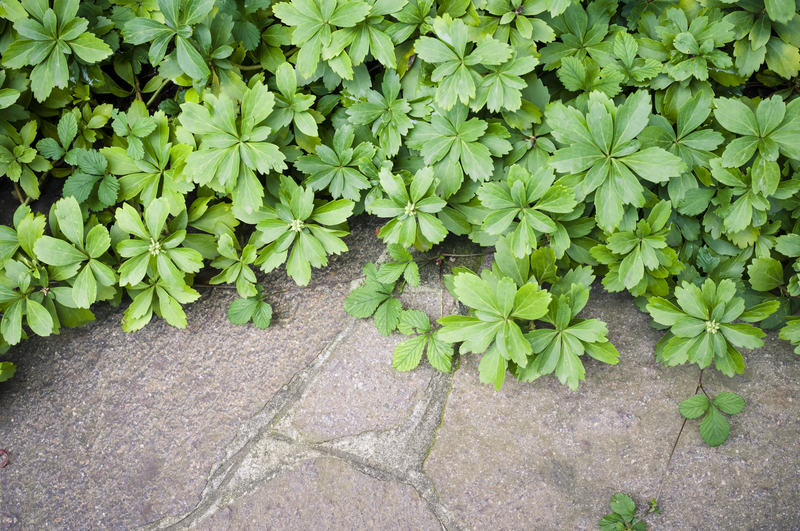Building a Garden That Stands Strong Against Weather
Posted on 23/05/2025
Building a Garden That Stands Strong Against Weather
A beautiful garden is the pride of any homeowner, providing a place of peace, color, and natural wonder. However, with unpredictable weather patterns becoming increasingly common, designing a garden that can withstand harsh weather is more crucial than ever. In this comprehensive guide, we will explore the best strategies for building a garden that stands strong against weather, offering tips and techniques to protect your outdoor haven from wind, rain, frost, and scorching sun.
Understanding Your Local Climate
The first step in creating a weather-resistant garden is understanding the specific weather patterns in your region. Knowing your climate zone will help you select appropriate plants and materials, ensuring your garden can thrive year-round.
Key Weather Factors to Consider
- Rainfall: Is your area prone to heavy rain or drought?
- Temperature Fluctuations: How hot do summers get, and how cold are winters?
- Frost Dates: When is your first and last frost of the season?
- Wind Exposure: Are you in an exposed or sheltered location?
- Sunlight Hours: How many hours of sunshine does your garden receive daily?
*Research your local weather data* and make notes. This knowledge will be the foundation for weatherproof landscape decisions.

Planning Your Weather-Resilient Garden Design
Create Microclimates For Extra Protection
By using structures like fences, hedges, and walls, you can moderate temperature and wind exposure within your garden. These features break up strong gusts, prevent frost pockets, and even reflect or provide shade from sunlight.
Smart Garden Layouts to Combat Harsh Weather
- Windbreaks: Plant dense shrubs or conifers on the windward side to shield delicate plants.
- Raised Beds: Use raised beds for better drainage and to prevent root rot during heavy rains.
- Natural Slopes: Take advantage of slopes to guide excess water away and prevent waterlogging.
- Strategic Planting: Position tender plants close to walls for residual heat or in partial shade for sun protection.
Choosing Weather-Resistant Plants
Selecting the right plants is essential for gardens that withstand extreme weather. Native or region-adapted plants tend to be hardier and better equipped for local weather conditions.
Attributes of Tough Garden Plants
- Drought-Tolerance: Plants like lavender, sedum, and ornamental grasses thrive in dry conditions.
- Flood-Resilience: Choose plants like willow or marsh marigold for wetter areas.
- Wind-Resistance: Sea buckthorn and juniper cope well in exposed environments.
- Frost-Hardiness: Consider hardy perennials such as hellebores and snowdrops for cold zones.
- Sun-Tolerance: Sunflowers, echinacea, and daylilies survive and flourish in intense sun.
Top Weatherproof Plant Choices
For a garden that stands strong against changing weather, incorporate a variety of plant types:
- Shrubs: Boxwood, holly, viburnum
- Perennials: Coneflower, catmint, black-eyed Susan
- Annuals: Zinnia, marigold, cosmos
- Groundcovers: Creeping thyme, ajuga, sedum
- Trees: Serviceberry, juniper, oak (for larger spaces)
Soil Preparation for Weather Resistance
The foundation of a resilient garden is healthy, well-prepared soil. Soil that drains well, retains moisture, and is rich in organic matter will protect plant roots from damage during weather extremes.
Improving Soil Drainage
In regions with heavy rainfall, it's crucial to enhance drainage to avoid root rot:
- Add Organic Matter: Compost, well-rotted manure, or leaf mold helps soil retain moisture yet drain well.
- Install Drainage Pipes: For persistent flooding, consider French drains or underground pipes to redirect water.
- Create Swales: Shallow, vegetated channels can help guide excess water away from plant roots.
Mulching for All-Weather Protection
Mulch acts as a protective blanket, regulating soil temperature, retaining moisture during drought, and preventing soil erosion in heavy rain.
- Organic options: Bark chips, straw, composted leaves
- Inorganic options: Gravel, landscape fabric (best for paths or driveways)
Effective Water Management for Extreme Conditions
Building a garden resilient to weather requires smart water management--protecting plants from both excess water and drought. Consider installing rain barrels to collect water and using soaker hoses for targeted irrigation when needed.
Drought-Proofing Your Garden
To conserve water and ensure your plants have enough during dry spells, try these techniques:
- Water Deeply, Less Often: Deep watering encourages roots to grow down, making plants sturdier.
- Mulch Generously: Reduces evaporation and keeps soil moist.
- Group Plants by Water Needs: Create zones so you can easily water only where it's most needed.
Dealing With Heavy Rain & Flooding
- Install Rain Gardens: Areas planted with moisture-loving species that absorb excess runoff.
- Direct Downspouts Away from Garden Beds: Prevents erosion and waterlogging.
- Avoid Compacting Soil: Aerate soil to maintain drainage and prevent standing water.
Providing Wind and Storm Protection
Strong winds can damage plants, flatten flowers, and even uproot trees. A garden that stands strong against severe weather incorporates both natural and structural windbreaks.
Natural Windbreaks
- Layered Planting: Use rows of trees, tall shrubs, and hedges to break up wind flow.
- Living Fences: Espaliered trees or climbing vines on trellises provide robust barriers.
- Bamboo Screens: Fast-growing bamboo varieties can serve as quick windbreak solutions, but ensure they're not invasive in your region.
Structural Protections
- Fencing: Solid fences shield delicate plants but use slatted designs to reduce wind pressure and prevent collapse.
- Raised Walls or Berms: Earth mounds or low walls can reroute strong winds above plant level.
Protecting Your Garden from Frost and Cold Snaps
Sudden frosts can devastate tender plants. Frost protection in gardens is essential for resilience in colder climates.
Frost-Defeating Strategies
- Choose Cold-Hardy Plants: Focus on varieties that survive frost in your zone.
- Use Cloches or Row Covers: Portable covers provide emergency insulation during cold snaps.
- Apply Mulch in Fall: Helps insulate roots from freezing overnight temperatures.
- Water Before Frost: Moist soil retains heat better and provides mild frost protection.
- Place Pots and Tubs Near Walls: Collects radiated heat from structures and keeps roots warmer.
Heat-Proofing Your Garden for Summer
As summers intensify, it's vital to build a garden that withstands heat waves and UV damage.
Key Strategies for Summer Survival
- Provide Shade: Use pergolas, shade cloth, or plant taller species to protect sensitive plants.
- Mulch Beds: Prevents rapid drying of the soil and keeps roots cool.
- Water Efficiently: Early morning or evening watering minimizes evaporation.
- Select Heat-Tolerant Plants: Mediterranean herbs (rosemary, oregano) and succulents thrive in full sun and heat.
Garden Structures for Weather Resilience
Incorporate sturdy structures in your garden design to improve protection against all types of weather.
- Arbors and Pergolas: Offer shade and anchor climbing plants. Consider models with removable covers for flexibility.
- Raised Planters: Boost drainage and make frost protection easier.
- Greenhouses and Cold Frames: Shelter tender plants in winter and protect early seedlings from late frosts.
- Retaining Walls: Prevent soil erosion and create microclimates for heat-loving or frost-resistant plants.
Maintenance Tips for a Weatherproof Garden
Maintaining your garden against changing weather is an ongoing effort. Proactively caring for your plants and structures maximizes your garden's resilience.
Key Maintenance Practices
- Regular Pruning: Remove dead or damaged growth to improve airflow and reduce wind resistance.
- Inspect for Pests and Disease: Damaged plants are more vulnerable to weather stress. Treat promptly.
- Top Up Mulch and Compost: Replenish each season for optimal root protection and soil health.
- Check Drainage: After heavy rain, ensure water isn't pooling or damaging roots.
- Secure Structures: Inspect fences, trellises, and plant supports before storms or high winds.

Sustainability Considerations for Weatherproof Gardens
A truly resilient garden not only survives the elements but thrives while supporting the local ecosystem. Use eco-friendly practices to reduce environmental impact and foster biodiversity.
- Plant Native Species: They're adapted to local weather and support bees, butterflies, and birds.
- Compost: Reduces garden waste, enriches soil, and improves moisture retention.
- Use Permeable Surfaces: Gravel paths or permeable pavers prevent runoff and support groundwater.
- Embrace Diversity: Plant a mix of trees, shrubs, perennials, and groundcovers to provide resilience and habitat.
Conclusion: Your Garden, Strong in Any Weather
Building a garden that stands strong against weather requires understanding your environment, thoughtful plant selection, climate-smart design, and diligent maintenance. By incorporating the strategies above, you can create a resilient outdoor haven that not only weathers the storms but flourishes in them. Remember, every garden is unique, so observe, adapt, and be ready to modify your approaches as conditions change. With the right planning and care, your garden will remain a thriving, beautiful retreat for years to come--no matter what the skies may bring.
Frequently Asked Questions
-
What are the best plants for a weather-resistant garden?
Native plants, as well as hardy perennials like echinacea, lavender, daylilies, hellebores, and black-eyed Susans, are great options. Incorporate a mix for best results. -
How can I protect my garden from heavy rain?
Improve soil drainage with organic matter, use raised beds, and install rain gardens to manage excess runoff effectively. -
How often should I mulch my garden?
Mulch in both spring and autumn, and top up as necessary, especially after extreme weather events.
Start implementing these tips and enjoy your resilient, weatherproof garden all year long!

